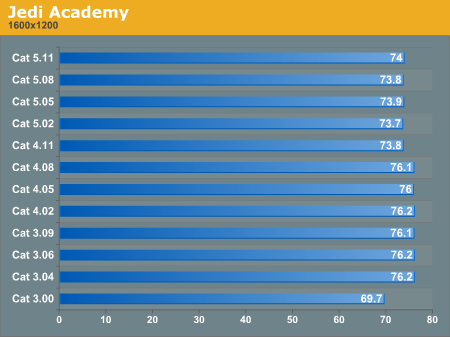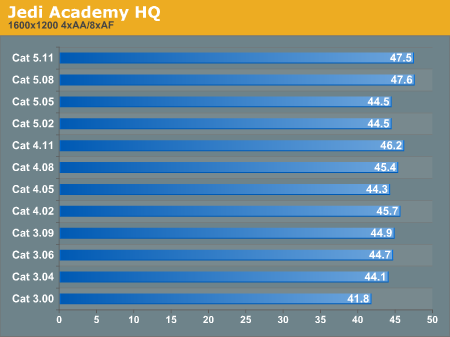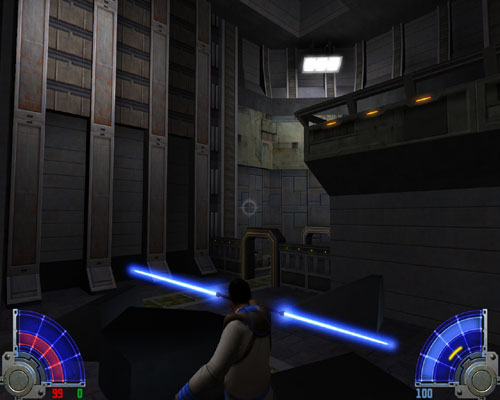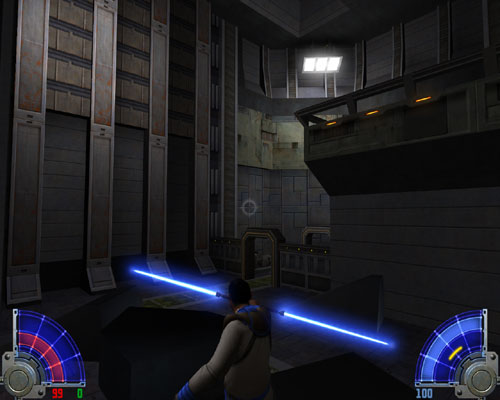Looking Back: ATI's Catalyst Drivers Exposed
by Ryan Smith on December 11, 2005 3:22 PM EST- Posted in
- GPUs
Jedi Knight: Jedi Academy
Released in 2003, Jedi Academy represents the pinnacle of what the Quake3 engine could offer. With massive levels, dynamic glow, and lightsabers abound, it's one of the most punishing Quake3 engine games ever made, and a good representation of the vast number of games made in the early 2000's with this engine. As our only OpenGL title in this roundup, it's also our gauge to see if ATI's OpenGL performance changed at all over the 3-year period That said, even with ATI's traditionally poor OpenGL performance, we still had to increase our testing resolution to 1600x1200 in order to put a sizable dent in to our test setup; otherwise, we would continuously hit the 100fps frame rate cap.
Looking at the screen captures, however, we see a very interesting story that the benchmarks do not show, and it's not all performance related.
Overall, however, Jedi Academy shows that other than early improvements and a bug fix, there was little change in performance in this game with the 9700 Pro.
Released in 2003, Jedi Academy represents the pinnacle of what the Quake3 engine could offer. With massive levels, dynamic glow, and lightsabers abound, it's one of the most punishing Quake3 engine games ever made, and a good representation of the vast number of games made in the early 2000's with this engine. As our only OpenGL title in this roundup, it's also our gauge to see if ATI's OpenGL performance changed at all over the 3-year period That said, even with ATI's traditionally poor OpenGL performance, we still had to increase our testing resolution to 1600x1200 in order to put a sizable dent in to our test setup; otherwise, we would continuously hit the 100fps frame rate cap.


Looking at the screen captures, however, we see a very interesting story that the benchmarks do not show, and it's not all performance related.

Catalyst 3.04 versus 3.00 (mouse over to see 3.00)

Catalyst 3.09 versus 3.06 (mouse over to see 3.06)
Overall, however, Jedi Academy shows that other than early improvements and a bug fix, there was little change in performance in this game with the 9700 Pro.










58 Comments
View All Comments
ksherman - Friday, December 16, 2005 - link
Any chance for a nVidia comparison? Ive ehear that some older drivers were better...semiconductorslave - Tuesday, December 13, 2005 - link
Great, I'll tell the person that bought my videocard three cards ago! Maybe next we could see an article about how adding 3 extra 16k memory cards to the Atari 800 improves games.HWAddict77 - Tuesday, December 13, 2005 - link
[lecture]Guess what? There is real value in the fact that the people writing these articles actually interact with us to find out what we think. In publishing, web-based or otherwise, that's rare and valuable, and it puts us in a pretty cool position if you ask me. So I think being a smartass is particularly lame. It's not like there are only 20 people reading the articles. Hell, it's not like there are only 1000 people reading them.
[/lecture]
My .02: I would also like to see a similar article with an Nvidia card.
semiconductorslave - Wednesday, December 14, 2005 - link
So your saying we can't use sarcasim to voice our opinions? I totally appreciate this site and all of the reviews, and hope the editors can handle a little bit of facetiousness every now and then. It is my attempt at humor and way of saying that I think this article, being more of a research piece into the history of driver support on an older card, is more academic and not very pragmatic. I'm not saying the author made the following assumtion, but it would be a logical fallacy for a person to assume the future will happen like the past. ATI could have better driver releases in the future, put more resources into it, hire more talented programers, also the hardware is always changing, like dual core CPUs and ring bus memory architectures on graphics cards. So I personaly don't think how the drivers perform on the old 9700pro make much difference to anyone but a person running the old 9700pro. This in turn will limit what games they can run since the newer games take a bit more power, especially with AA enabled, AS filtering, and HDR, so now--once again in my opinion--the article is most helpful to the person running old games on an old card.Still I read it.
jeffrey - Monday, December 12, 2005 - link
Ryan Smith,Thank you for publishing this article! The whole idea of the article itself is what makes me so happy. It was not another "product release -> generate review" type article. This article stepped-out of that mold and required thinking of an idea and then testing to find the result. Kudos!
What made the article an A+ was that the results were not there. To clarify, I should say expected results. ATI has been promising increase after increase, but after several generations, there just was not a whole lot there.
ATI has impressed with monthly driver releases, but performance gains are limited. I am NOT disapointed with the results. ATI's claims for driver improvements are rarely across the board. More often than not, the claim of a gain is focused on a particular generation, segment, or resolution.
One important fact that was left out of the review was compatibility. A central focus of each Catalyst release is fixing bugs to make the drivers more stable. The commitment from the Catalyst crew to providing incremental optimizations has mainly been secondary this year to resolving driver issues. The graphs might show an image that looks like not a whole lot has been done. However, if you included a total of bug fixes from Catalyst 3.0 to 5.12 the image of that graph would be impressive indeed.
ATI's monthly Catalyst updates have been invaluable to their reputation as a provider of graphics solutions. How many companies have checked-in and checked-out within a couple of years due to drivers never "maturing". ATI has a positive image today in regards to drivers and that alone is a barrier to entry for new competition.
I could go on and on, but if by chance you get down to my post please feel free to pat yourself on the back and share this with Anand.
Thanks again,
Jeffrey
timmiser - Tuesday, December 13, 2005 - link
I agree. This article was definitely outside the mold and nothing like this had been done before. (To see driver improvements over years instead of months.)Nighteye2 - Monday, December 12, 2005 - link
Nice article. Now I want to see the same test for Nvidia drivers :)MrJim - Monday, December 12, 2005 - link
Mr Ryan Smith>It would be nice to see a flightsim or a racing sim! Maybe a newer one with impressive graphics like Lock-On/Lo-Mac(Flightsim) for example. Interesting article!ShadowVlican - Monday, December 12, 2005 - link
now to anyone that still says ATi has bad drivers... i will refer them to this review (6)bldckstark - Monday, December 12, 2005 - link
I don't see where this proves they have GOOD drivers either. They had on average some minor improvements in FPS and fixed some IQ issues. Yes there were some nuggets of enlightenment, but overall the greatest increase was in eventually eliminating a huge IQ flaw in soft lighting.